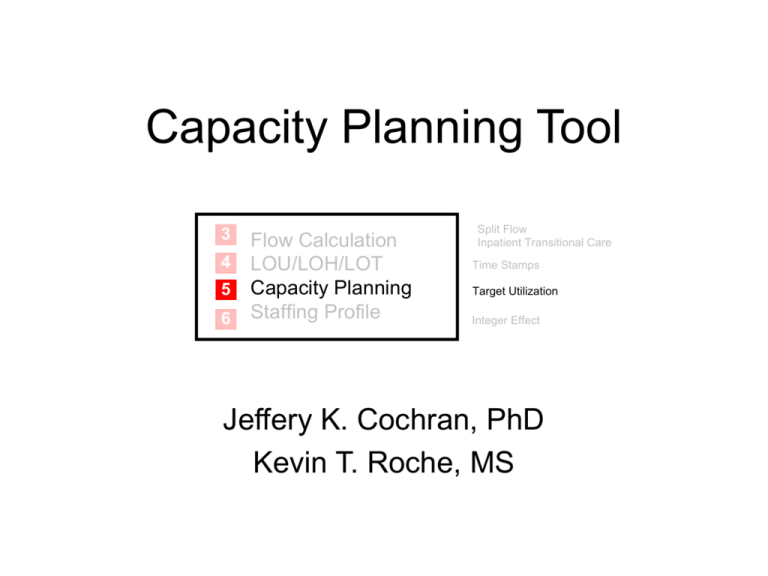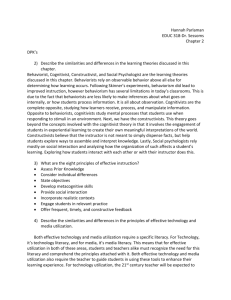Capacity Planning Tool
advertisement

Capacity Planning Tool
3
4
5
6
Flow Calculation
LOU/LOH/LOT
Capacity Planning
Staffing Profile
Split Flow
Inpatient Transitional Care
Time Stamps
Target Utilization
Integer Effect
Jeffery K. Cochran, PhD
Kevin T. Roche, MS
Analysis Goals
• With this tool, the user will be able to
answer the question: “How much space is
required in each area of my split flow
network?”
– Space will defined as providers or physical
patient capacity, depending upon the area.
• This decision is based on acuity split, area
arrival rates, service times, and target
performance measures.
Patient Safety Performance Measures
Estimated Using Queuing Theory [1][2][3]
• Server Utilization (ρ)
– The average percent of time a resource is “busy”.
– Bed utilization is the average percent of time a bed is occupied by a
patient.
– Provider utilization is average percent of time spent in direct patient care.
• Wait in Queue (Wq)
– The average length of time a patient will spend waiting for service in an
area before starting service.
• Full/Busy Probability (pc)
– The fraction of arriving patients who must wait in an area until a resource
becomes available. The table below defines resources by area.
Resource Being
Capacitated
Interpretation of Full/Busy Probability (pc)
Quick Look
Provider
The average fraction of time all providers are busy.
Intake/Discharge
Provider
The average fraction of time all providers are busy.
Results Waiting
Space
The average fraction of time that all spaces are full.
IPED
Space
The average fraction of time that all spaces are full.
Inpatient Transitional Care
Space
The average fraction of time that all spaces are full.
Area
Tool 5 Calculations
• Utilization (ρ):
[4]
* LOS
c
• Expected wait time in queue (Wq):
c 1 * LOS n * LOS c
where: p0
n!
c! 1
n 0
* LOS c
C s 2 Ca 2
p0 *
Wq
2
c! c 1 2
LOS
1
* LOS c
• Full/Busy probability (pC):
• Door-to-Doc (D2D) time:
pc
c!
c
* LOS i
i!
i 0
Notation Key:
LOS = {LOU, LOH, or LOT}
c = number of area servers
λ = area arrival rate
Cs, Ca = Coefficient of
variation of the service and
arrival processes, respectively
D2D time WqQUICK LOOK LOS QUICK LOOK f1 f 2 travelQUICK LOOK IPED Wq IPED
f 3 f 4 f 5 travelQUICK LOOK INTAKE Wq INTAKE
Fraction of lower
acuity patients
Fraction of higher
acuity patients
Tool 5 Input Data
• Arrivals per hour to each location in the
Split ED – 3
• Mean LOS and coefficient of variation
in each location:
– Tool 4 provides inputs for Results
Waiting, IPED, and Admit Hold
– Defaults can be used in Registration
and OPED
• Travel times (new data): Quick Look to
OPED and Quick Look to IPED
From 4
The EXCEL® Tool 5
Purpose: Estimate, using queuing theory, patient-safe capacities in each split flow area.
INPUT
Arrivals/Hr:
Area
Quick Look
Intake/Discharge
Results Waiting
IPED
Inpatient Transitional Care
Quick Look
12.62
Number of
Servers Required
2
6
30
20
10
DOOR-TO-DOC TIMES:
INPUT:
Travel time from Quick Look to OP ED (min.) =
Travel time from Quick Look to IP ED (min.) =
Intake/Discharge Results Waiting
23.08
11.27
INPUTS
Average
Time (min.)
7.5
11.3
120.0
238.0
131.0
Coefficient
of Variation
0.19
0.37
1.00
0.71
1.60
From
IPED
3.36
Inpatient Transitional Care
2.78
Avg. Server
Utilization (ρ)
78.9%
72.1%
75.1%
66.6%
60.7%
----OUTPUTS---Avg. Wait in
Queue (Wq) (min)
6.40
1.42
1.51
1.67
6.39
3
Full / Busy
Probability (pC )
32.6%
14.1%
2.5%
2.2%
4.5%
4
5.0
Travel time input
5.0
3
OUTPUT:
Average Lower Acuity Door-to-Doc Time =
Average Higher Acuity Door-to-Doc Time =
Overall Average Door-to-Doc Time =
From
4
20.3
20.6
20.3
Minutes
Minutes
Minutes
5
6
Flow Calculation
LOU/LOH/LOT
Capacity Planning
Staffing Profile
Split Flow
Admit Hold
Time Stamps
Target Utilization
Integer Effect
Iterating on the Number of Servers
• After input data is entered, you can allocate servers to each area
• More servers means better performance measures and better
patient safety, but more expense
• Select scenarios that best balance capacity costs and patient safety
– Utilization = 70% usually provides good balance and starting point
– Utilization cell goes RED for ρ ≥ 100% implying not enough servers
Adjust these fields to achieve desirable performance measures
“One-up, One-down” Summary Table
• Once acceptable service levels are chosen, the ‘one-up, one-down’
table can be a useful summary of results for discussion.
• In each area, add one server and note results, then subtract one
server and note results. The table includes all three:
Average
Volume/Hr LOU (min.)
Area
Quick Look
Quick Look
Quick Look
Intake/Discharge
Intake/Discharge
Intake/Discharge
Results Waiting
Results Waiting
Results Waiting
IPED
IPED
IPED
Inpatient Transitional Care
Inpatient Transitional Care
Inpatient Transitional Care
12.62
7.5
23.08
11.3
11.27
120.0
3.36
238.0
2.78
131.0
Number of Servers
1 server
2 servers
3 servers
5 docs, 15 rooms
6 docs, 18 rooms
7 docs, 21 rooms
29 spaces
30 spaces
31 spaces
19 beds
Waiting Time
Utilization
(min.)
>100%
78.9%
6.40
52.6%
0.73
86.9%
6.53
72.4%
1.42
62.1%
0.44
77.7%
2.55
75.1%
1.51
72.7%
0.89
74.0%
3.25
}
32.6%
14.6%
23.0%
14.3%
8.1%
3.4%
2.5%
1.8%
4.9%
20 beds
70.1%
1.67
3.3%
21 beds
9 beds
10 beds
11 beds
66.6%
67.4%
60.7%
55.2%
0.84
16.44
6.39
2.50
2.2%
7.8%
4.5%
2.4%
M/G/c results
The shaded numbers
are used to estimate
Average D2D time:
Full / Busy
Probability
D2D time 6.42 7.5 0.28% 8.28% 5 1.67
M/G/c/c
results
68.73% 20.53% 2.18% 5 1.42 20.3 minutes
Summary / Next Steps
• We can look at capacity requirements over any range of
volumes
Provider Capacity and Resulting Utilization in
Intake/Discharge
100%
7
80%
6
5
60%
4
40%
3
2
Providers Required
1
20%
Provider Utilization
Example ED
volume: 233
visits/day
301
315
329
247
260
274
288
205
219
233
192
137
151
164
178
110
123
82
96
0%
55
68
0
Provider Utilization
Providers Required
8
Daily Emergency Department Volume
• 3:1 Room:Provider ratio rule in Intake provides areas for
patient staging, while, from a queuing perspective, a 2:1
ratio provides low room overflow probabilities.
• Now we can use Tool 6 to see how all areas should be
staffed.
References
[1] contains the theory of estimating performance measures in a queue.
[2] discusses its use in this Toolkit.
[3] uses queuing theory in a nine-node split ED.
[4] presents the Allen-Cunneen approximation for wait in queue calculations
[1]
Gross D, Harris CM. Fundamentals of Queueing Theory, 3rd edition. New
York: John Wiley and Sons, Inc.; 1998.
[2]
Roche KT, Cochran JK. Improving patient safety by maximizing fast-track
benefits in the emergency department – A queuing network approach.
Proceedings of the 2007 Industrial Engineering Research Conference,
eds. Bayraksan G, Lin W, Son Y, Wysk R. 2007. pg. 619-624.
[3]
Cochran JK, Roche KT (submitted). A multi-class queuing network
analysis methodology for improving hospital emergency department
performance, Computers and Operations Research 2007.
[4]
Allen AO. Probability, Statistics, and Queueing Theory with Computer
Science Applications. London: Academic Press, Inc.; 1978.







